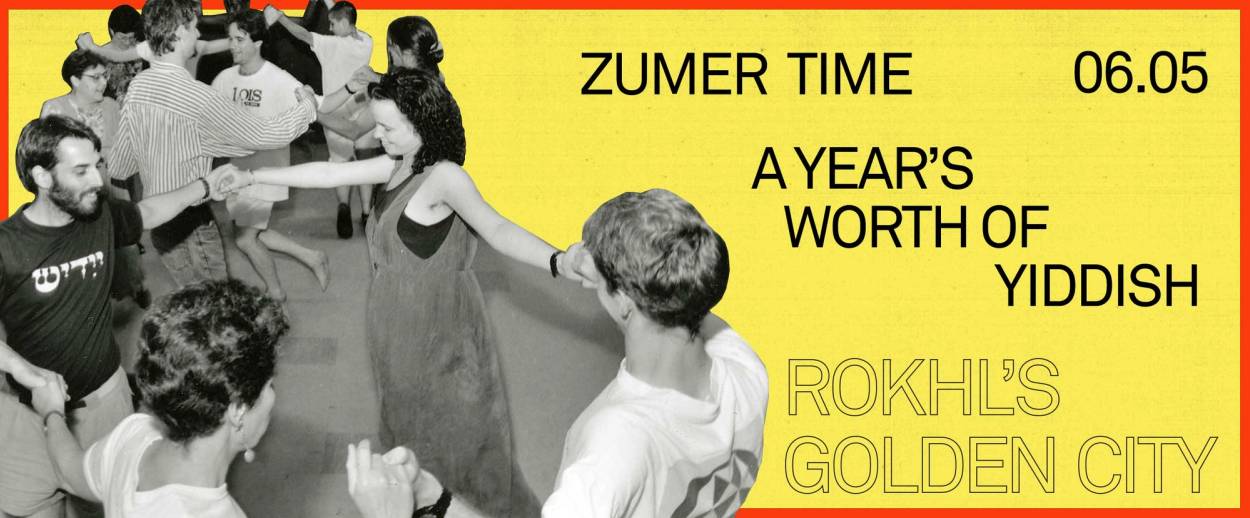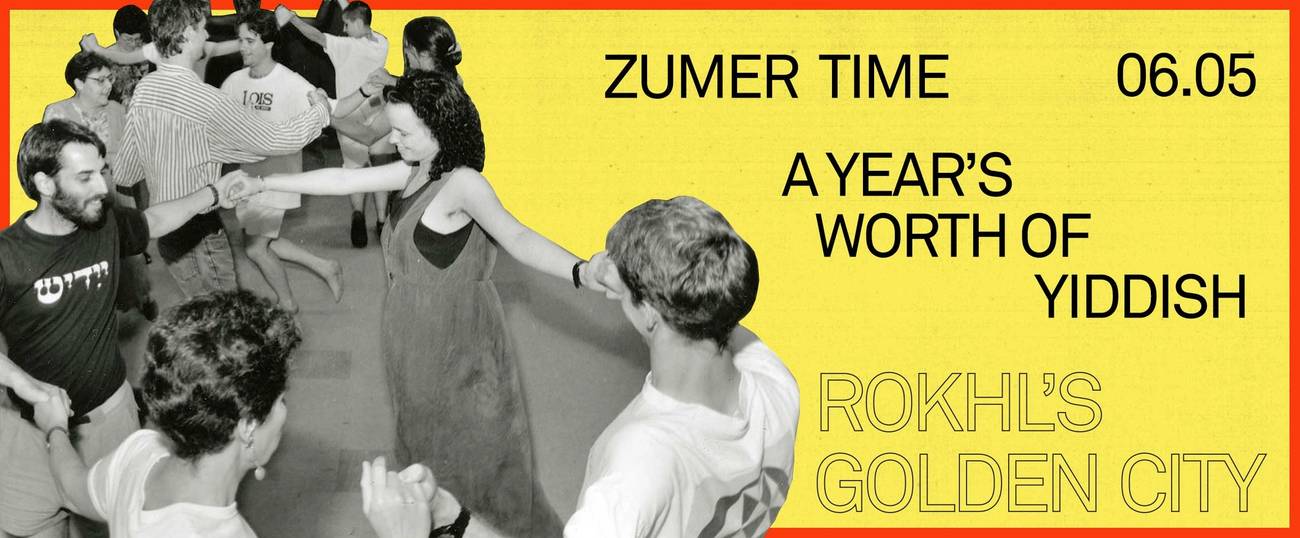Summertime and the Yiddish Is Easy
Rokhl’s Golden City: Why I’m skipping the beach to spend the season studying




Some people dream of lazy summers by the lake. I dream of summer school.
Summer language school, to be specific. Why would I want to be on vacation when I could be spending five hours a day in a classroom? Also, I can’t swim.
The summer language immersion program has been part of the American college landscape for over a hundred years. Probably the most famous is Middlebury College’s program, in Vermont, inaugurated in 1915 with a German summer school. Students don’t just study the language, they live in it, taking a pledge to only speak the target language while in the program. In return, a student can expect to acquire a year’s worth of language competency in one summer.
In an unexpected, but happy, turn of events, I’m going to be a first-time participant at the famed Uriel Weinreich Summer Program in Yiddish Language, Literature, and Culture, known to the rest of us simply as the zumer-program (summer program). Held at the Center for Jewish History, it’s an intensive language-immersion program that at one time had a substantive Yiddish-only housing aspect to the experience. Given the exigencies of New York living, that option has somewhat faded away.
The zumer-program differs in two substantive ways from other summer language-immersion programs. First, obviously, no one is preparing for a semester or year abroad in Yiddishland. Indeed, YIVO is Yiddishland, or at least, its capital. Second, it’s still not possible to major in Yiddish at an American university. Instead, the zumer-program is accessible to undergraduates and provides a wide ranging, high-level training in the field of Yiddish, with an interdisciplinary approach. Classes are offered in ethnography, literature, history, musicology, research methods, and pedagogy.
When I queried my friends on their recollections of their time in the zumer-program, they came back with descriptions like “transformative,” “mesmerizing,” “life changing,” and “like drinking from a fire hose.”
One friend of mine, a zumer-programnik 25 years ago and now a teacher there, described his time as a student as resembling the scene in Sleeper with the pleasure orb. But, you know, Yiddish. So, how the hell is this my first summer in attendance? It’s not for lack of trying.
I have a vivid memory of first hearing about the zumer-program as an undergraduate. It was in the gym at Brandeis. I was working out (sitting on the weight machines and shmoozing) with one of my Yiddish class friends, a grad student who went by the name Shprintze. After a couple semesters together, our little group had become preternaturally tightknit.
Shprintze had just done the zumer-program, but apparently had not found it as transformative as others had. The singalongs left her cold. She was unimpressed by her klezmer celebrity classmate. Everything she described with cynical weariness I found utterly thrilling. Then again, before I lost touch with her, Shprintze had given up the practice of comparative literature for medical school, so maybe she was just drinking from the wrong fire hose.
My friend Zachary Baker is the recently retired Reinhard Family Curator for Judaica and Hebraica Collections at Stanford University. He was part of the fourth class at the zumer-program in 1971, about which he wrote, lovingly: “Although the classes that I took at Columbia were being offered for credit by an Ivy League university, the Summer Yiddish Program was essentially an enterprise in cultural indoctrination.” It’s probably too late now, but I always wondered what my life would have been like if someone had tried to indoctrinate me, even just a little.
Clicking through a gallery of photos from zumer-program classes over the years is a who’s who of the modern Yiddish world—plus Naomi Wolf’s father, Leonard Wolf, a scholar of classic horror novels with a sideline in Yiddish translation.
The zumer-program opened in 1968. Interestingly, it began as a way of offering a mitlshul (Yiddish supplementary school) education to high school graduates without a Yiddish background. It quickly became apparent that there was enormous interest from undergraduate and graduate students who wanted to work on their Yiddish as part of ongoing academic studies. Though it’s named for the prodigiously talented Uriel Weinreich, its genesis goes back to the summer of 1948, when his father, Max, also a prodigiously talented historian and sociologist, began planting the seeds for academic Yiddish in the United States.
Max Weinreich was one of the founders of YIVO in Vilna in 1925. At the outbreak of the war he was at an academic conference in Denmark. Max, his wife Regine, and their two teenage sons, Gabriel and Uriel, escaped to New York. There, the American section of YIVO (the Amopteyl in YIVO loshn) was eventually built up into the new YIVO headquarters.
In 1948, hoping to encourage UCLA to establish a chair in Yiddish, Weinreich arrived in Los Angeles to lead a now legendary summer course for graduate students. Los Angeles was an important hub of Yiddish life, second only to New York. With community funding, Weinreich selected 12 graduate fellows to take part in the program. As Mark L. Smith describes in his article “UCLA’s First Yiddish Moment: Max Weinreich at UCLA in 1948,” the participants were chosen not just based on their excellent academic records, but on their commitment to the project of building up Yiddish in America: “Beyond the specifics of course content and individual students’ papers, Weinreich’s chief aim at UCLA was to demonstrate a means of countering linguistic assimilation.”
The summer course would demonstrate the potential and seriousness of Yiddish studies. But the fellows were to be emissaries to the greater student body. In that respect they were successful even beyond Weinreich’s hopes. The graduate classes attracted numerous auditors. The fellows’ weekly Yiddish song sessions drew up to 100 participants. Students with no Yiddish knowledge started asking for an introductory-level course, which was quickly arranged and enthusiastically attended, even though it was not being offered for credit.
The textbook for that class was an early mimeographed version of Uriel Weinreich’s College Yiddish, which would go on to be the standard Yiddish textbook for decades. Uriel Weinreich published College Yiddish at age 23 and finished his landmark dictionary that year, too, though it would not be published for many years after. Four years later, having written his dissertation in six months, Uriel would take the first university chair in Yiddish in the linguistics department at Columbia.
YIVO and Columbia would become the hub of academic Yiddish in the following years, but Max Weinreich’s dream of setting the stage for the establishment of Yiddish studies in America was mostly unfulfilled. Indeed, as Barbara Kirshenblatt-Gimblett wrote in 2013 in “Yiddish Studies: Toward a Twenty-First Century Mandate” (foreword to Choosing Yiddish: New Frontiers of Language and Culture), the study of Yiddish “has been damned for so long by fear of its ideological investments …” Because most of the Yiddish students in the United States are Jewish, “the fear is that Yiddish will not be taken seriously if it is seen as a variety of ethnic studies; the anxiety persists that students will come to Yiddish on a quest for their roots rather than as serious scholars and that the field will be partisan and parochial as a result.” This is, of course, what Max Weinreich wanted. Not that new scholarship would be stunted, but that young Jews would come to Yiddish seeking something deeper than just a field of study.
Kirshenblatt-Gimblett is a hero of mine, but I find her remarks puzzling. I’m not an academic and have only an outsider’s familiarity with the contours of Yiddish studies over the last 50 years. And perhaps this makes me sound hopelessly naïve. But given the almost superhuman achievements of Max and Uriel Weinreich, and the example they set balancing meticulous scholarship and engaged activism, it’s hard to understand why a personal investment in Yiddish is today presumed to be in conflict with dispassionate scholarship.
But it is absolutely true that for many of the scholars involved with Yiddish today, anything even hinting at Yiddishism is strenuously avoided. Though I have tremendous admiration for the achievements of these scholars, it seems unfortunate that the model of Weinreichian engagement has been shunned. Especially since I suspect that no matter what, those who hate or ridicule Yiddish based on their ideologies (or ignorance) will continue to do so, no matter how passionately Yiddish scholars cultivate their dispassion.
Tragically, after a highly productive number of years for father and son, Uriel died in 1967 at age 40. He had produced more scholarship than some scholars do in a lifetime. His dictionary was published posthumously and the new YIVO summer program was named for him. In 1969, Max Weinreich also died. Both had influenced every field they touched. It’s hard for me to think of them and not be overcome by what they achieved, and what we lost.
LEARN: It’s too late to sign up for this year’s zumer-program, but the Workmen’s Circle is offering a full slate of summer classes, starting July 1. You have the choice of in-person classes or distance learning, so you’ve got no excuses. … Learn more about the history of YIVO and academic Yiddish at “The Rise of Yiddish Scholarship and the History of YIVO” on Monday July 15, 4 p.m. … If you can’t make it to the event, read Cecile Kuznitz’s groundbreaking history of YIVO. … If you want to hear more about Uriel Weinreich there are two excellent YIVO programs available online, both by Dr. Rakhmiel Peltz. “Forging a Field: Recovering Uriel Weinreich’s Research on Yiddish Culture in Eastern Europe” is in English and “Uriel Weinreich: A Bridge in Jewish Culture Between Eastern Europe and America” is in Yiddish.
ALSO: Guitarist Gary Lucas performs his live score for the silent film The Golem at LES movie palace Metrograph, June 16. … Tsibele violinist Zoe Aqua presents an evening of Yiddish women’s songs at Barbes, June 20 at 8 p.m. … Also June 20, Tincu Brazil presents “From Afro-Sambas to Afro-Yiddish,” a musical evening in Long Island City. … Boston Klezmer band Ezekiel’s Wheels hits New York on June 29. … If you read me regularly, you know that I’m obsessed with everything to do with Oyneg Shabes member Rokhl Oyerbakh. Historian Sam Kassow will be talking about Oyerbakh at YIVO, July 29, at 4 p.m., at YIVO. … Gefilteria, the cutting edge of the Ashkenazi food renaissance, will be leading an Eastern European tour, October 2019. There’s still time to get the early bird discount. … Check out a new online exhibit about Jewish Buenos Aires, featuring lots of Yiddish content.
***
Like this article? Sign up for our Daily Digest to get Tablet magazine’s new content in your inbox each morning.
Rokhl Kafrissen is a New York-based cultural critic and playwright.